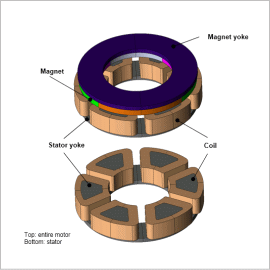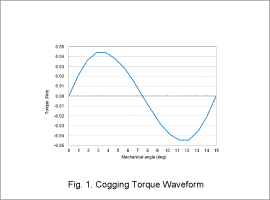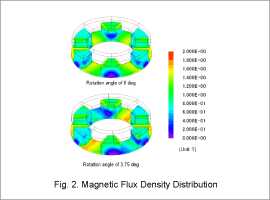*Please prepare a license ID and password for the license administrator.
*It is different from the service for JMAG WEB MEMBER (free membership). Please be careful.
Overview

An axial gap type motor has a motor structure in which the rotor and stator are arranged in a disk shape facing each other and rotate using magnetic flux in the axial direction. The advantages of this motor are that this motor can be made thinner than a radial gap type motor, and that higher torque can be obtained for a given magnetic flux density if properly designed. This motor has been developed for a variety of uses including automobiles, and can respond to market demands with its unique design.
In an axial gap type motor, 3D electromagnetic field simulation is necessary because the magnetic flux passing through the facing rotor and stator is a 3D magnetic circuit.
In this example, presents an example of cogging torque analysis of an axial gap type motor.
In an axial gap type motor, 3D electromagnetic field simulation is necessary because the magnetic flux passing through the facing rotor and stator is a 3D magnetic circuit.
In this example, presents an example of cogging torque analysis of an axial gap type motor.
Cogging Torque Waveform

A cogging torque waveform is shown in Fig. 1.
This result shows that the amplitude is approximately 0.044 Nm. The cogging torque period is determined by the number of slots and the number of poles. Since this analysis target has 8 poles and 6 slots, the cogging torque period is 15 deg obtained by dividing 360 by 24, the least common multiple of 6 and 8. The torque waveform result is periodic and has a period of 15 deg as well, and since the coils are not excited the torque waveform has half-wave symmetry.
This result shows that the amplitude is approximately 0.044 Nm. The cogging torque period is determined by the number of slots and the number of poles. Since this analysis target has 8 poles and 6 slots, the cogging torque period is 15 deg obtained by dividing 360 by 24, the least common multiple of 6 and 8. The torque waveform result is periodic and has a period of 15 deg as well, and since the coils are not excited the torque waveform has half-wave symmetry.
Magnetic Flux Density Distribution

Fig. 2 shows the magnetic flux density distribution for a rotation angle of 0 deg and for 3.75 deg.
The symmetry of the magnetic flux density distribution seen at the rotation angle of 0 deg is not seen at the rotation angle of 3.75 deg. Cogging torque is generated by this phenomenon.
The symmetry of the magnetic flux density distribution seen at the rotation angle of 0 deg is not seen at the rotation angle of 3.75 deg. Cogging torque is generated by this phenomenon.


